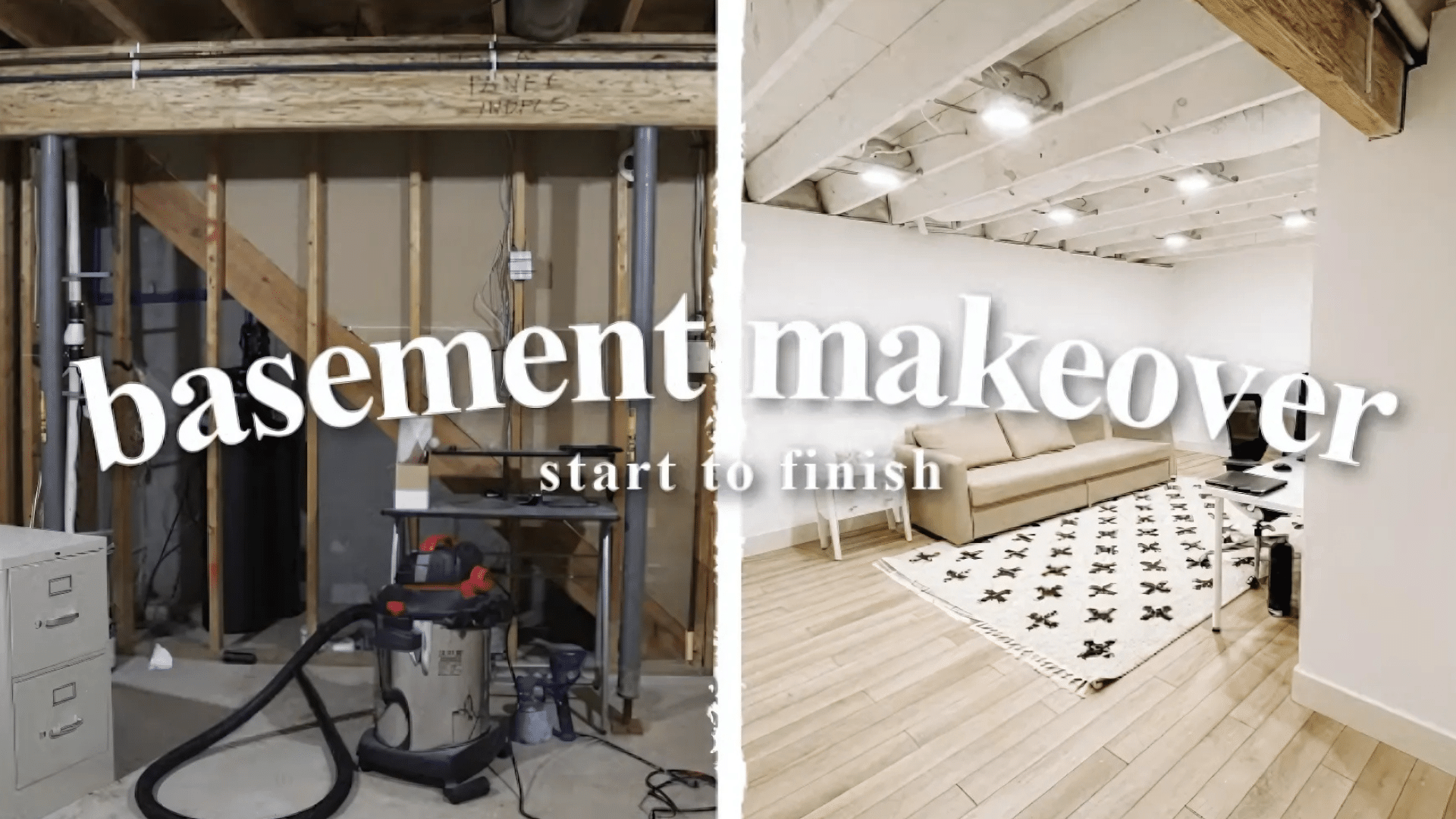Want to add more space to your home? An unfinished basement could be your answer. Many homeowners leave their basements unused for years. With some work and planning, this space can become a cozy area.
This guide will show you how to change a cold, concrete space into a warm, useful room.
The basement in this project sat unused for about two and a half years. Then, over five months, it became a functional space with proper lighting, walls, and floors. This wasn’t a solo job – it took teamwork between the homeowner and a friend with some skills.
You’ll learn what tools and supplies you need. We’ll also walk through each step of the process.
By the end, you’ll see how a plain basement can become a useful part of your home.
Budget-Friendly Basement Makeovers: A Step-by-Step Guide
Tools and Materials Needed
| Tools | Materials |
|---|---|
| Hammer | Insulation |
| Drill | 2×3 lumber for framing |
| Saw | Drywall sheets |
| Level | Drywall screws |
| Measuring tape | Drywall mud/joint compound |
| Sanding tools | Drywall tape |
| Paint brushes & rollers | Paint (white for ceiling, color of choice for walls) |
| Caulking gun | Trim paint (creamy off-white) |
| Utility knife | Waterproof flooring |
| Carpet (optional) | |
| Light fixtures | |
| Electrical wiring and outlets | |
| Door for storage area |
Step 1: Plan Your Space
Start by thinking about how you want to use your basement. This will help you plan the layout. In this project, the goals were:
- Creating an office space
- Making a living area
- Adding a storage room
- Keeping the ceiling open for height
Draw a simple floor plan showing where the walls will go—Mark where you want electrical outlets and lights. Consider any special needs, like a TV mount.
Step 2: Add Insulation
Insulation is the first major step in a basement project. It keeps the space warmer and makes it more comfortable.
- Start with the outer walls that touch the foundation
- Install insulation between the floor joists above
- This step may take several evenings to complete
The homeowner started this step in December and worked on it during the evenings.
Step 3: Paint the Ceiling
Consider whether to close in the ceiling or keep it open:
- An open ceiling makes the room feel bigger
- A closed ceiling can look more finished but lowers the height
In this project, they chose to paint the open ceiling white:
- Use a good primer first if needed
- Apply at least two coats of white paint
- This brightens the space considerably
- Plan for this to take several days with drying time
Step 6: Install Drywall
Drywall turns your framing into actual walls:
- Measure and cut drywall sheets to fit
- Attach to the framing with drywall screws
- Work from corners outward
- Cut holes for outlets and switches
Step 5: Install Flooring
Flooring makes a huge difference in comfort:
- For the main area, they chose waterproof flooring from Lowe’s in “Barren Oak.”
- Light colors help make the basement feel bigger
- For stairs, they added carpet for comfort and sound reduction
- The carpet installation cost around $500 and was professionally done
Step 6: Add Finishing Touches
Complete the space with:
- Install trim around floors and doors
- Add outlet covers
- Install stair handrails
- Bring in furniture that fits your needs
- Consider a rug for warmth and sound absorption
Video Tutorial
Check out this YouTube video for a detailed step-by-step Guide on Affordable Basement Renovations.
Tips for Maintenance and Care of Basement
1. Monitor for Water Issues
Check for water issues regularly in your basement. Walk around all walls and floors every month. Look for damp spots, discoloration, or changes in texture. Even small leaks can cause big problems if left untreated.
Water damage leads to mold, rotting wood, and costly repairs. Pay special attention to areas near pipes and exterior walls. If you spot any signs of moisture, act fast to find and fix the source.
2. Control Humidity Levels
Run a dehumidifier in damp weather to keep moisture levels low. Basements tend to collect humidity due to their below-ground location. Aim to keep humidity between 30% and 50% for comfort and to prevent mold growth.
Empty the dehumidifier tank regularly or set up a drain hose. Change or clean the filter as recommended by the manufacturer. Consider a model with a humidistat that turns on automatically when needed.
3. Clean Floor Coverings
Clean carpets yearly to prevent allergens from building up. Basement carpets collect more dust, pet hair, and moisture than other areas of your home.
Rent a carpet cleaner or hire professionals for a deep clean. For non-carpet flooring, mop with appropriate cleaners every few weeks. Sweep or vacuum regularly to prevent dirt from scratching the surface place mats near entrances to catch dirt before it spreads.
4. Maintain Paint and Finishes
Touch up paint as needed to keep the space looking fresh. Keep extra paint on hand for quick fixes. Small scratches and scuffs add up over time, making the room look worn. Clean the walls with a gentle solution before painting.
Use a small brush for touch-ups rather than rollers for minor fixes. Check trim and doors for wear as well. Sand lightly before applying new paint for the best finish.
5. Inspect Electrical Components
Check that all electrical components are working properly at least twice a year. Test all outlets with an outlet tester. Make sure light switches function smoothly without flickering. Replace burnt-out bulbs promptly.
Look for any discoloration around outlets or switches that might indicate overheating. Avoid running extension cords under rugs or furniture. If you notice any issues, consult an electrician for safety.
6. Seal Cracks and Gaps
Apply new caulk around any seams that may crack over time. Check where walls meet the floor and ceiling. Look for separation between trim and walls. Seal any gaps around pipes or vents that enter walls.
Choose the right type of caulk for each application: silicone for areas exposed to moisture and acrylic for paintable surfaces. Removing old, failing caulk completely before applying new will ensure a better seal.
Things to Avoid in a Basement Renovation
| Things to Avoid | Description |
|---|---|
| Rushing drywall work | Poor mudding and sanding are shown in the final result. Take your time for smooth walls. |
| Skipping insulation | Without proper insulation, your basement will feel cold and damp year-round. |
| Ignoring building codes | Many areas require permits for basement work. Check local rules before starting. |
| Placing furniture against outer walls | Leave space between furniture and outside walls unless properly insulated. |
| Amateur electrical work | Incorrect wiring can create fire hazards. Hire a professional for electrical needs. |
| Using standard drywall | Choose moisture-resistant drywall for basement applications to prevent mold. |
| Neglecting small water issues | Minor leaks become major problems quickly in basement environments. |
| Overloading electrical circuits | Plan your electrical needs carefully to avoid tripping breakers or creating hazards. |
| Leaving the ceiling unpainted | A white ceiling makes the space feel much brighter and more open. |
| Forgetting about temperature control | Plan for proper heating and cooling to make the space comfortable all year. |
Conclusion
Turning an unfinished basement into a useful space adds value to your home and gives you extra room for work, play, or storage. The project may take several months, especially if you work on it during evenings and weekends, but the results are worth the effort.
This basement was transformed from a cold concrete storage area to a warm, bright, multi-use space, which took about five months of part-time work.
Some steps required professional help, but the homeowner and a friend completed most.
What makes the biggest difference? The white ceiling brightens the whole space. The proper walls make it feel like a real room. And the flooring turns cold concrete into a comfortable place to walk.
Remember, you don’t need to finish every little detail right away. Do the major work first, then add the final touches over time.
The most important thing is creating a useful space that adds to your home’s function and value.
Also, check out our blog on budget-friendly basement ideas!















One Comment
https://pinupaz.top/# pin-up